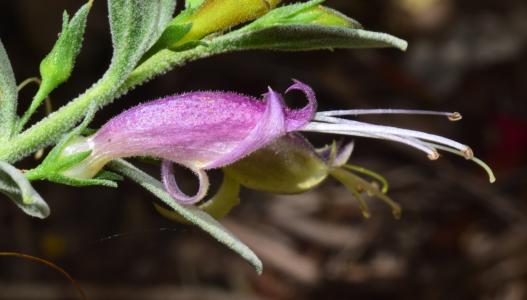Plants in my Garden
By Mike Beamish
Species: Eremophila ‘Augusta Storm’ (E. glabra x E. veneta). Family: Scrophulariaceae (was Myoporaceae).

Derivation:
Eremophila: From Greek, eremos, meaning desert or lonely place, and the suffix -phileo, meaning to love, thus a lover of deserts or lonely places.
glabra: From Latin, glaber, meaning without hair, perhaps referring to the gynoecium (female parts of the flower).
veneta: A Latin word meaning bluish green and referring to the flower colour.
Common Name: None.
Distribution: This plant has no known natural distribution; it is a hybrid of garden origin. E. veneta occurs in the Avon district of South-west WA, around Corrigin, Gnowangerup, Kent, Kondinin, Kulin and Lake Grace, where it overlaps with E. glabra subsp. albicans, so it is possible that some similar natural hybrids exist in these areas.
Description: A small shrub up to 1m tall and broad with silvery-green foliage and tubular, purple flowers to 25mm long at any time of year, with flushes usually in autumn and spring and after rain.
Opinion: A lovely little plant when it is at its best, but it does the same thing that a lot of other Emu-bushes do in my garden, it loses most of its leaves behind the growing tip so that the end result is a leggy plant with bare branches and a little tuft of leaves at the tip. I presume this is a reaction to growing the plant in conditions nothing like its usual habitat; that is, cooler and damper Boolarra versus warmer and drier wheat-belt WA. How to counteract this tendency? Provide more light, warmth and air movement around the plants, regularly tip prune to slow down the growing points and encourage bushiness. I do try, but I’m not winning.
My specimen is planted in the northern bed, up against the fence that divides my front and back yards, in a line of four different Eremophila species. My theory was that they would receive plenty of direct light during the middle of the day, though not much in the mornings and late afternoons. The fence would reflect light and warmth back onto the plants, but would also restrict air movement a bit, perhaps too much. The theory hasn’t worked as hoped; three of the four plants have dropped most of their leaves and Augusta Storm is virtually prostrate with bare branches up to 60cm long, ending in a nearly invisible tuft of leaves. It still flowers, the honeyeaters still love it, but aesthetically it’s a failure. Maybe treating it as an annual, or biennial at most, is the way to go.
The Australian Plants Society Latrobe Valley Group hosts monthly activities, excursions and/or meetings. Interested persons are welcome to join in, please contact Mike for more information - Email mcandcjb@gmail.com or phone 0447 452 755.
Sources: Elliot & Jones – Encyclopaedia of Australian Plants, Volume 3.
Chinnock – Eremophila and Allied Genera.
Sharr – WA Plant Names and their Meanings.
Online – FloraBase: Flora of WA.


